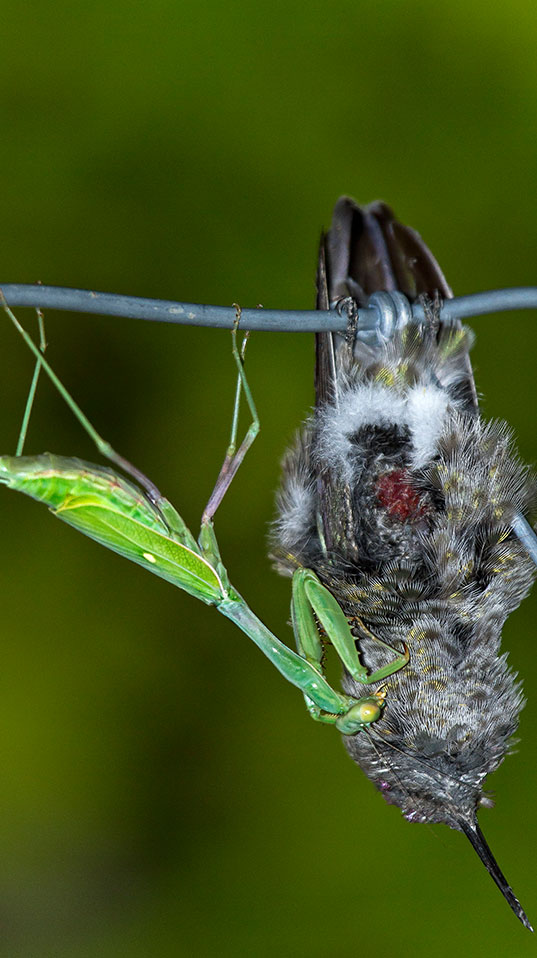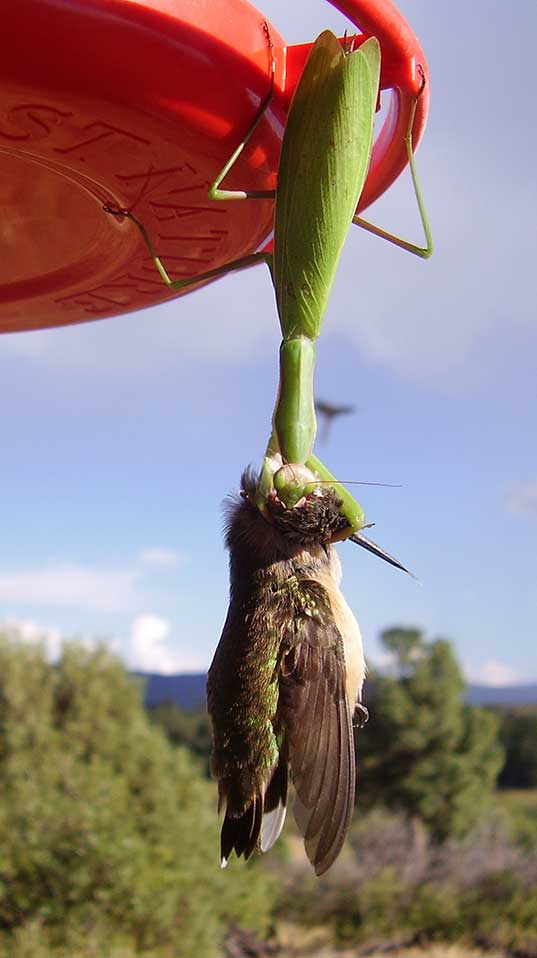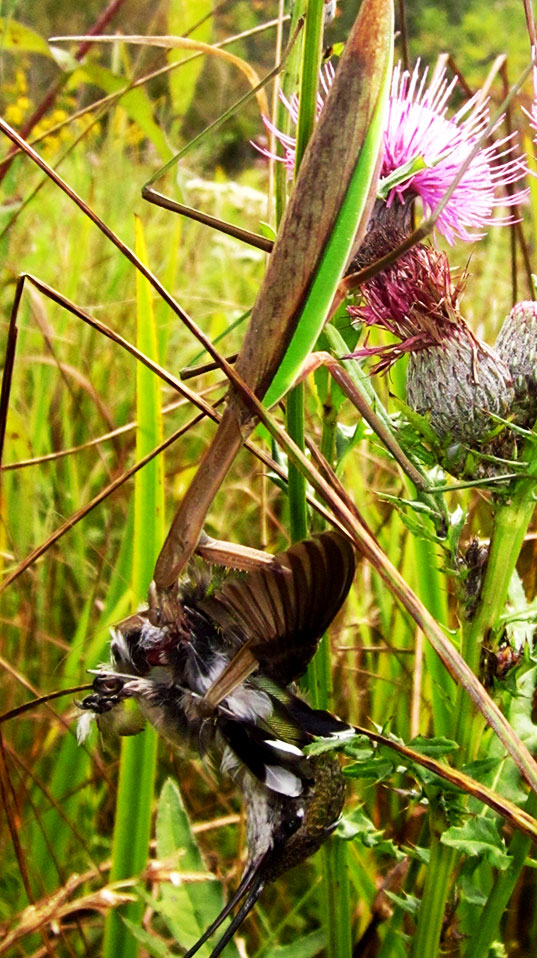Giant bugs with a taste for meat sounds more sci-fi than fiction. But this horrifying hunger is more widespread than we think, and could be happening in your own backyard.I'm not talking about blood-thirsty spiders, or anthropomorphic cockroaches. No, I'm referring to praying mantises and their penchant for catching and consuming birds. Bird-eating mantises are a feat of nature that's rarely seen by humans. Yet, this phenomenon was curious enough for a group of zoologists from Switzerland and the United States to investigate. Knowing that praying mantises are carnivorous, not to mention voracious hunters, the researchers pored over 147 incidents—both amateur and scholarly—of mantis-on-bird predation, hoping to find clues about this behavior."Most experienced birders and ornithologists have at least heard about this behavior, but most backyard birders are still shocked to hear about it," Kenn Kaufman, a field editor at the National Audubon Society who was not involved in the study, told me in an email. "One of the bird magazines published a photo of a mantis munching on a hummingbird a few years back, and as you might imagine, some readers totally lost their shit over it."
Bird-eating mantises are a feat of nature that's rarely seen by humans. Yet, this phenomenon was curious enough for a group of zoologists from Switzerland and the United States to investigate. Knowing that praying mantises are carnivorous, not to mention voracious hunters, the researchers pored over 147 incidents—both amateur and scholarly—of mantis-on-bird predation, hoping to find clues about this behavior."Most experienced birders and ornithologists have at least heard about this behavior, but most backyard birders are still shocked to hear about it," Kenn Kaufman, a field editor at the National Audubon Society who was not involved in the study, told me in an email. "One of the bird magazines published a photo of a mantis munching on a hummingbird a few years back, and as you might imagine, some readers totally lost their shit over it." The group's findings, which were recently published in the Wilson Journal of Ornithology, suggest that mantises all over the world are chowing down on unsuspecting avians. Praying mantises were observed eating 24 different bird species across 14 families. Nearly 70 percent of accounts happened in North America, where tiny hummingbirds were the most common prey. States with the highest incidents of this, according to the study, were New York, North Carolina, Texas, Arizona, and California."In the older literature, there are all sorts of anecdotes of mantises eating bizarre prey, such as centipedes and poisonous spiders, but these were usually 'Gladiator' encounters where investigators would throw together a mantis and another fearsome invertebrate in a jar or cage," Michael Maxwell, the study's co-author and a behavioral ecologist at National University, told me in an email.But sites like YouTube have made it easier for modern scientists to collect footage of mantises capturing birds in the wild. The idea to review reports of attacks stemmed from wanting "to sort out who is predator and who is prey," Maxwell added.Interestingly, this behavior was observed on every continent except Antarctica, spanning twelve mantid species—something the study's lead author Martin Nyffeler, a senior lecturer at the University of Basel, called "a spectacular discovery" in a statement."For many of us, the most surprising thing about the new study is the range of non-hummingbirds recorded as mantis prey," Kaufman added. "The others are all very small songbirds, but still, some of them must weigh as much as one-third of an ounce, which seems like a lot for any insect to deal with."Weirdly, all of the mantises were identified as female. Females aren't necessarily more aggressive, but they do engage in sexual cannibalism if very hungry. Twice, female mantids were observed feeding on a bird while also mating with a male.The implications of this weren't addressed in the study, but the authors noted that predation often involved larger mantids, averaging six centimeters in body length. Coincidentally, some species of praying mantis are sexually dimorphic in size, meaning females outweigh their male counterparts.Most birds were ambushed at feeders, where mantises would almost always go for the head, neck, or throat. Their victims usually died within minutes, but not without a struggle. Mantids occasionally scalped and decapitated their prey, which might sound needlessly brutal, but is something female mantises have been known to do to males after mating with them.Here's an especially gory attack method described in the study:
The group's findings, which were recently published in the Wilson Journal of Ornithology, suggest that mantises all over the world are chowing down on unsuspecting avians. Praying mantises were observed eating 24 different bird species across 14 families. Nearly 70 percent of accounts happened in North America, where tiny hummingbirds were the most common prey. States with the highest incidents of this, according to the study, were New York, North Carolina, Texas, Arizona, and California."In the older literature, there are all sorts of anecdotes of mantises eating bizarre prey, such as centipedes and poisonous spiders, but these were usually 'Gladiator' encounters where investigators would throw together a mantis and another fearsome invertebrate in a jar or cage," Michael Maxwell, the study's co-author and a behavioral ecologist at National University, told me in an email.But sites like YouTube have made it easier for modern scientists to collect footage of mantises capturing birds in the wild. The idea to review reports of attacks stemmed from wanting "to sort out who is predator and who is prey," Maxwell added.Interestingly, this behavior was observed on every continent except Antarctica, spanning twelve mantid species—something the study's lead author Martin Nyffeler, a senior lecturer at the University of Basel, called "a spectacular discovery" in a statement."For many of us, the most surprising thing about the new study is the range of non-hummingbirds recorded as mantis prey," Kaufman added. "The others are all very small songbirds, but still, some of them must weigh as much as one-third of an ounce, which seems like a lot for any insect to deal with."Weirdly, all of the mantises were identified as female. Females aren't necessarily more aggressive, but they do engage in sexual cannibalism if very hungry. Twice, female mantids were observed feeding on a bird while also mating with a male.The implications of this weren't addressed in the study, but the authors noted that predation often involved larger mantids, averaging six centimeters in body length. Coincidentally, some species of praying mantis are sexually dimorphic in size, meaning females outweigh their male counterparts.Most birds were ambushed at feeders, where mantises would almost always go for the head, neck, or throat. Their victims usually died within minutes, but not without a struggle. Mantids occasionally scalped and decapitated their prey, which might sound needlessly brutal, but is something female mantises have been known to do to males after mating with them.Here's an especially gory attack method described in the study: That said, should you start killing every praying mantis you see? Definitely not.During the last century, two species of large mantids, the European Mantis ( Mantis religiosa) and Chinese Mantis (Tenodera aridifolia sinensis), were introduced to North America as a form of pest control. The study theorized these mantises could pose a risk to the region's hummingbird populations. But while mantises may chow down on a bird or two, they're by no means a bigger threat to hummingbirds than, say, habitat loss."As weird/gruesome as the behavior seems, I don't think it represents a threat to the survival of any hummingbird species, because it doesn't happen very often relative to the total population," Kaufman said. "So I'd say it's an interesting phenomenon but not a conservation concern."So if you see a mantis devouring a bird, maybe don't get involved. Just cover your eyes, and remember what we like to say here: nature is violent.Update: This story has been edited to include a quote from the study's co-author Michael Maxwell.
That said, should you start killing every praying mantis you see? Definitely not.During the last century, two species of large mantids, the European Mantis ( Mantis religiosa) and Chinese Mantis (Tenodera aridifolia sinensis), were introduced to North America as a form of pest control. The study theorized these mantises could pose a risk to the region's hummingbird populations. But while mantises may chow down on a bird or two, they're by no means a bigger threat to hummingbirds than, say, habitat loss."As weird/gruesome as the behavior seems, I don't think it represents a threat to the survival of any hummingbird species, because it doesn't happen very often relative to the total population," Kaufman said. "So I'd say it's an interesting phenomenon but not a conservation concern."So if you see a mantis devouring a bird, maybe don't get involved. Just cover your eyes, and remember what we like to say here: nature is violent.Update: This story has been edited to include a quote from the study's co-author Michael Maxwell.

Advertisement

Advertisement
Advertisement
The modus operandi of the mantis seems to be to approach the bird, which is always hanging downwards, and then enter the cranial cavity via one of the eyes, feeding on the brain tissues… We found several instances of the mantis feeding on the head of the bird, and on at least two occasions the mantis cut the head when it finished.

